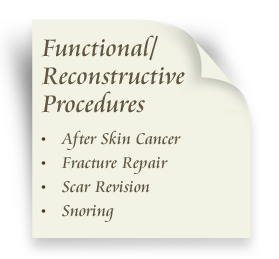
Making Facial Scars Less Visible
No plastic surgeon, no matter how talented, is able to completely remove a scar and make it invisible. However, Dr. Morrow can make your scars less conspicuous through scar revision techniques involving direct excision, reorientation with flaps, replacement with grafts, or resurfacing with the laser.
How Scars are Formed—and Treated with Plastic Surgery
Scars form any time the deeper layers of skin are cut or torn. The scar's appearance is affected by the size and depth of the wound, the blood supply to the area, the skin's color and thickness, and the direction of the scar. There are several different types of scars that form for a variety of reasons, each responding to different treatments. In some cases, more than one treatment, or a combination of techniques, may be needed to obtain the best results. Although scars cannot be eliminated entirely, these special techniques can help make them less conspicuous.
Keloids are thick mounds of red or dark scar tissue that result from an over-production of collagen that grows beyond the margins of the original wound. Injecting steroid directly into the scar tissue will help reduce redness, itching, and burning. It also helps stop collagen production, allowing the scar to flatten and fade over time. If necessary, the scar tissue may be excised and closed with traditional scar revision techniques.
Hypertrophic scars are thick, red, and raised. Unlike keloids, a hypertrophic scar remains within the boundaries of the original incision or wound. Steroids given topically or by injection are used initially to treat these scars. When necessary, surgical scar revision can be performed to allow it to heal in a less conspicuous pattern.
Contracture occurs when burns or other major injuries form a scar that pulls the edges of the skin together (contraction). The resulting contracture may involve adjacent muscles and tendons, thereby restricting normal movement. Correcting a contracture may involve cutting out the scar tissue and replacing it with a skin graft or flap. Sometimes techniques called a Z-plasty or W-plasty are used. These two procedures involve different ways in which a contracted scar is released, using incisions that resemble a Z or W, depending upon the scar's severity.
Raised or bumpy scars may respond to resurfacing techniques with lasers. There are a variety of lasers, each with a different wavelength of light, that vaporize scar tissue with little or no damage to surrounding areas of normal skin.
Depressed scars may respond well to dermal fillers injected to elevate the scar.
Whatever type of scar you may have, chances are Dr. Morrow can make it appear smaller and less visible to others. Contact us today to arrange a consultation.






